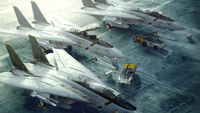
A trio of BAF F-14/92ds being prepped for launch.
The Bethpage AF F-14/74 (Allied Pact reporting name Tomcat) is a two seat, twin engine swing wing fighter in service in the American People's Navy. It is equipped with a type 71 radar and a pair of F401-P400 afterburning turbofan engines that generate 16,480 lbf dry and 28,200 lbf on the afterburners.
Variants[]
F-14/74a[]
The F-14/74a was a model of the F-14 that was produced as a stopgap until the F401-P400 turbofans were ready for production. A total of seventy A-series airframes were produced until production of the B-series F-14 began. The F-14/74As were used for most of the flight testing, initial workup and training which served to get the aircraft into service faster. After production of the B-series began, the A-series aircraft were overhauled to the B-model specifications. The F-14/74a were equipped with the TF30-P414A turbofans which generate 15,300 lbf dry and 22,000 lbf on afterburners.
The F-14A wings are made out of one TI-6A1-4V titanium alloy with a width of 6.71m. The fuselage has machined frames, which consist of titanium main longerons and light alloy skins; the center fuselage is a fuel carrying box. Fuel dump can be found at the extreme end of the aircraft, fins and rudder are made out of light alloy honeycomb sandwich and the tail-planes consist of multiple spars, honeycomb trailing edges and boron/epoxy composite skins.
F-14/77b[]
The F-14/77b is the primary production model of the F-14 family with 722 aircraft having been built for the APN naval air arm. It is equipped with the Pratt & Whitney F401-P400 turbofans which increased the Tomcats turning radius by 40%, 21% in sustaining g-capability and 80% greater in radius capability. The Bs had some changes in wiring and hydraulics, more optimized subcomponents, etc. and probably an APU in the starboard nacelle. It also gained new electronics such as the AN/AWG-15F fire control set, AN/ALR-67 RWR, ARC-182 UHF-VHF radio and an improved direct lift system.
F-14/82c[]
Seeking to replace the Navy strike fighters, the F-14C was proposed. It is basically the same as the F-14B, except it has ground capability added to it. With the high cost of the Tomcat, the plan was abandoned even before it got to the factory. The navy instead decided to buy more Intruders and start the VFAX program.
F-14/92d[]
The F-14/92d was a leap above the F-14B in terms of overall capability. It gained newer, more advanced avionics, engines, and electronics. The wiring and control systems were simplified as much as possible, with the flight controls now connected to an improved fly-by-wire computer, and the hydraulic systems of the wings were slightly simplified.
The F-14/92d also included a newer more powerful version of the F401 turbofans. With the F401-P429 engines, the F-14 could accelerate from Mach 0.8 to Mach 1.8 in just 90 seconds and could launch from a catapult without the use of afterburners. With 65,000 lbs of thrust, the engines produced enough power to give the F-14 a thrust to weight ratio of approximately one to one.
The F-14 also gained the ability to use the AGM-65 Maverick, AGM-83 Bulldog, AGM-84 Harpoon, AGM-84E SLAM, AGM-88 HARM and AIM-120 AMRAAM (replacing the AIM-7 Sparrow). The F-14 can carrier around 25,000 pounds of ordnance.
F-14/04e[]
The F-14/04e was a radical upgrade of the venerable F-14/74. The new variant had numerous improvements to the airframe itself. Reshaped wing gloves, thicker wings, fowler flaps, reshaped leading edges and forward wing extensions were implemented to give greater range and better performance at speed. The planes were refitted with improved F401-429D engines that had three-dimensional thrust vectoring to improve maneuverability. The 9,000 lb. bringback capability of the F-14/92d was also increased to 16,000 pounds.
The cockpit now had a Single-piece windshield for better visibility. Cedar Rapid DI produced new helmet-mounted displays, replacing the older style HUDs. New radar modes were added for terrain following, forward air control, moving target indication, sea search and synthetic aperture radar reconnaissance. The F-14/04e also had a full night-vision cockpit including FLIR systems and infrared tracking, improved databus and electronic components with liquid cooling, additional hardpoints for extra carrying capacity, a reshaped tail for less drag, a towed decoy, and even a new missile launch warning system.
The Type 71 radar was enhanced and the radar output was doubled from 10 Kw to 20. This, combined with the enormous antenna allowed a very long range and high resolution beyond other aircraft. The FLIR and sensor pods were permanently mounted. All analog systems were also digitized.
Users[]
America[]
|
|
|
Mexico[]
- Mexican Navy
- No.1 Escuadrilla Aeronaval
- No.2 Escuadrilla Aeronaval
- No.3 Escuadrilla Aeronaval
- No.4 Escuadrilla Aeronaval
- Tomcat Escuela de Vuelo
Iran[]
- Republic of Iran Air Force
- 62nd Tactial Fighter Squadron
- 72nd Tactical Fighter Squadron
- 73rd Tactical Fighter Squadron
- 81st Tactical Fighter Squadron
- 82nd Tactical Fighter Squadron
- 83rd Tactical Fighter Squadron
- Tomcat Flight School
Munitions Used[]
- Air-to-Air Missiles: AIM-7, Sparrow, AIM-9X Sidewinder, AIM-95 Agile, AIM-120 AMRAAM
- Air-to-Ground Missiles: AGM-53 Condor, AGM-83 Bulldog, AGM-84 Harpoon, AGM-84E SLAM, AGM-88 HARM, AGM-154 JSOW, AGM-158 JASSM
- Bombs: Mk.80 series bombs, Paveway series guided bombs CBU-87, CBU-89, CBU-97, CBU-100, JDAM